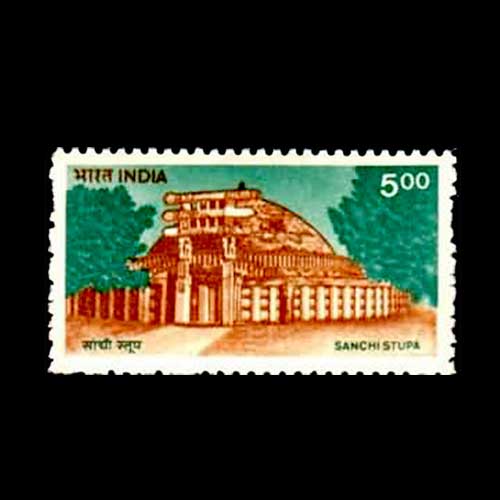Fascinating Archaeological Facts on Postage Stamps - 20
2025-05-06 Tue
Emperor ashoka commissioned the Construction of several stupas and monuments to spread and sustain Buddhism throughout the Indian subcontinent, and beyond in South-East Asia. Ashoka had marital relations with the region of Vidisha in Madhya Pradesh. The Great Stupa at Sanchi near Vidisha stands out as one of the most important Buddhist structures. This UNESCO World Heritage Site was established in the 3rd century BCE and is recognized as the oldest Stone structure in India. It contains a Central chamber that houses the relics of Lord Buddha and his chief disciples, and key figures in spreading Buddhism - Sariputta (Shariputra) and Moggallana (Maudgalyayana).Stupas are dome-shaped structures used as Buddhist shrines, primarily for meditation and housing relics of the Buddha or other significant Figures. Originating in ancient India, they symbolize the Buddha's enlightened mind and the path to Nirvana. Architecturally, they typically feature a hemispherical dome, a square base, and a spire, with symbolic elements like the harmika (platform) and chhatra (umbrella) representing spiritual stages.
The Great Stupa is believed to have served as a vital religious center from the 3rd century BCE to the 13th century CE. Initially constructed under Ashoka's reign, the stupa has undergone numerous expansions over the centuries. Its dome reaches a height of approximately 16 meters and has a diameter of 36 meters. During the Shunga dynasty, the structure was enlarged, doubling its size and incorporating sandstone slabs into the mound's covering. Additional features, including the vedika, pradakshina, and harmika, were included during this period.
The four cardinal points of the stupa are adorned with intricately carved rock gateways, or toranas, created during the #Satavahana period. These toranas depict significant scenes from the life of Buddha and the history of Buddhism, with inscriptions in #Brahmi honoring the individuals who contributed to their construction (For more information refer to https://x.com/MintageWorld/status/1908440610383573178)
Further enhancements, such as a Buddhist temple, a lion pillar, and a victory inscription from Chandragupta II, were added during the Gupta period.
On April 4, 1994, #India Post issued a definitive stamp featuring the Sanchi Stupa, valued at Rs 5, highlighting this remarkable surviving wonder of ancient India!
Latest News
-
Science and Technology on Indian Postage Stamps-6
2025-11-12 WedSir Mokshagundam Visvesvaraya is regarded as one of India's most distinguished engineers. His innova...
-
Science and Technology on Indian Postage Stamps-5
2025-11-11 TueSir Jagadish Chandra Bose recognized as India's first biophysicist was born on 30 November 1858, in ...
-
'Al-Sultan' Type Copper Double Falus of Malwa Sultan Ghiyath Shah
2025-11-07 FriAnother type of Copper Double Falus of Malwa Sultan Ghiyath Shah, weighing 17.5-18.1g. <br><br> I...
-
Science and Technology on Indian Postage Stamps-4
2025-11-07 FriThe last stamp in the series issued by India Post on 11 September 1997, to commemorate the 50th anni...
-
Science and Technology on Indian Postage Stamps-3
2025-11-06 ThuThe next #stamp in the series issued by #India #post on 11 #September 1997 commemorates the 50th an...

